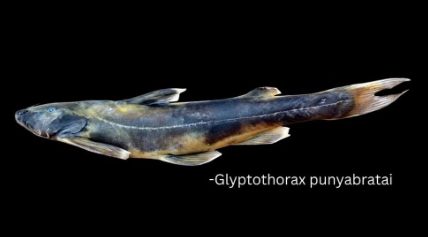Unveiling the Rich Biodiversity: Discovery of Glyptothorax punyabratai in Arunachal Pradesh (GS Paper 3, Science & Technology)

Introduction
- The recent discovery of Glyptothorax punyabratai, a new species of catfish, in the Tung Stream of the Brahmaputra River drainage system marks a significant addition to India's diverse aquatic fauna.
- Unveiled by the leading institute for fish genetic resources, ICAR-NBFGR, this discovery sheds light on the rich biodiversity of Arunachal Pradesh and underscores the importance of conservation efforts in preserving these unique species.
Distinctive Features of Glyptothorax punyabratai
- Glyptothorax punyabratai, named in honor of Dr. Punyabarata Das, showcases distinctive characteristics that set it apart within the genus Glyptothorax.
- With its adapted body shape and armor-like skin features, this catfish species is well-suited for clinging onto rocks in fast-flowing waters, contributing to its ecological niche within its native habitat.
- Its discovery highlights the remarkable adaptations of aquatic organisms to diverse environments.
Contributions to Aquatic Ecosystems
- Like other members of the Glyptothorax genus, Glyptothorax punyabratai plays a crucial role in the aquatic ecosystem.
- As a part of the food web, it contributes to nutrient cycling and maintains ecological balance.
- Understanding the ecological significance of such species is vital for informed conservation strategies and sustainable management of freshwater resources.
Other Notable Species in Arunachal Pradesh
Arunachal Pradesh, renowned for its rich biodiversity, harbors numerous species of fish, each with its own unique adaptations and ecological roles. Some notable species found in the region include:
1. Neolissochilus hexagonolepis (Hexagon Barb): Endemic to the Brahmaputra basin, this barb species exhibits distinct hexagonal scales and is prized for its ornamental value in the aquarium trade.
2. Oreichthys crenuchoides (Hillstream Loach): Adapted to fast-flowing streams, this loach species possesses specialized morphological features, such as flattened bodies and suction cup-like mouths, enabling it to thrive in its rocky habitat.
3. Tor progeneius (Progeneius Mahseer): A flagship species of the region, the Progeneius Mahseer is an iconic freshwater fish known for its large size and sporting qualities, making it a target species for anglers and a symbol of conservation efforts.
Conservation Efforts and Future Research
- The discovery of Glyptothorax punyabratai underscores the importance of continued research and conservation efforts to safeguard the biodiversity of Arunachal Pradesh.
- Institutions like ICAR-NBFGR play a crucial role in studying, conserving, and managing fish genetic resources, ensuring the sustainable utilization of aquatic ecosystems for future generations.
About ICAR-NBFGR
- Established in 1983, the ICAR-National Bureau of Fish Genetic Resources is dedicated to the conservation, management, and study of fish genetic resources in India.
- Through its research initiatives, the bureau contributes to the development of sustainable aquaculture practices and the enhancement of fish production, ultimately supporting food security and economic growth in the aquaculture sector.


